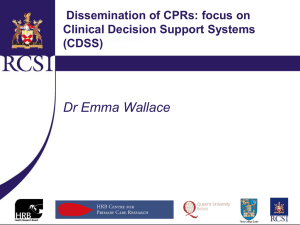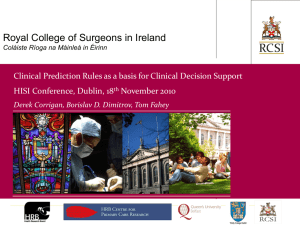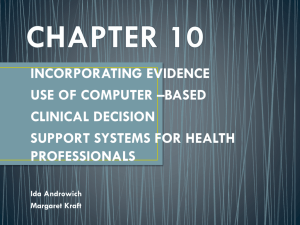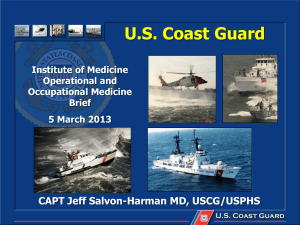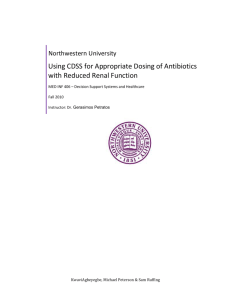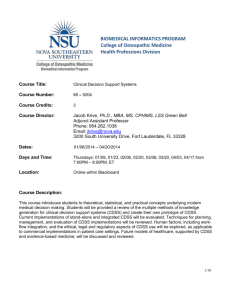Document
advertisement
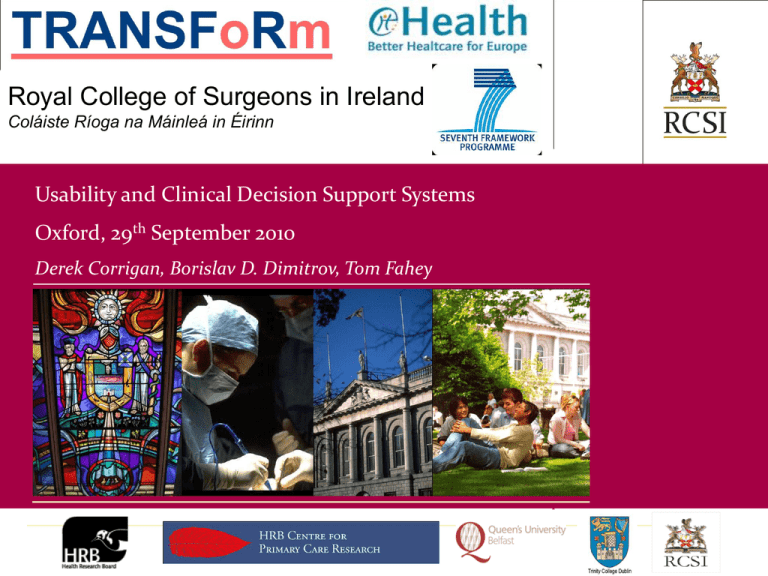
Royal College of Surgeons in Ireland Coláiste Ríoga na Máinleá in Éirinn Usability and Clinical Decision Support Systems Oxford, 29th September 2010 Derek Corrigan, Borislav D. Dimitrov, Tom Fahey PHS / Department of General Practice Overview • What is a Clinical Decision Support System? • What are the technical barriers to be considered? – “usability” issues • What role can Clinical Predication Rules (CPRs) play in a CDSS? • What form might a state of the art CPR based system look like? • What are the challenges to achieving this state of the art? PHS / Department of General Practice Clinical Decision Support Systems • Clinical decision support system (CDSS) – I.T. based systems that are designed to improve clinical decision making by suggesting possible clinical actions/interventions based on an underlying clinical evidence base • CDSS Types – Diagnostic systems – diagnose appendicitis – Reminder systems – generate patient letters – Disease management systems – diabetes management – Drug dosing/prescribing – insulin, warfarin PHS / Department of General Practice CDSS - Barriers to Implementation • Human Issues – As previously discussed - knowledge, attitudes, behavior • Technical Issues – Need to consider usability issues of CDSS and how we can potentially use CPRs as part of them PHS / Department of General Practice CDSS - Usability Issues 10 Commandments for Effective CDSS – (Bates et al 2003) • CDSS must fit into the clinical workflow – logical sequence and steps – Primary care diagnosis tool on laptop or PC in practice as part of consultation – Secondary care drug administration as part of round system may need something more mobile and compact – palm held application – No point developing tools that can only be accessed outside of the clinical process workflow – they are then seen as an additional overhead • Speed is everything – users will not tolerate slow systems! – No matter how useful an application is, it will not be used if performance is prohibitively slow – need to prototype and user test during development PHS / Department of General Practice CDSS - Usability Issues (contd.) • Deliver needs in real time – relevant information presented as needed - user should not need to go searching for information – In drug prescription systems, one action may imply another associated action that the system can automatically prompt for e.g. drug interactions, corollary orders or order sets – Do not wait until end of the entire process to highlight issues to the user • Physicians will resist stopping – offer alternatives and overrides – Users will not accept blanket restrictions – result in lack of confidence and frustration – Provide alternative suggestions justified by clinical evidence and always allow override of recommended actions – ultimately the clinician must be trusted PHS / Department of General Practice CDSS - Usability Issues (contd.) • Changing direction in a system is easier than stopping – – – – • Can modify clinician behavior with beneficial results Change default medication dosages based on evidence Change default frequency of dosage based on evidence Bates et al detail a change resulting in cost savings of $250,000 per year Monitor impact of CDSS and usage patterns and revise – – – – Understand how clinicians are using your system Track underlying usage of rules, alerts and overrides Large levels of overrides indicate potential problem Amend evidence base where necessary and/or provide more detailed justification PHS / Department of General Practice CDSS - Usability Issues (contd.) • Simple interventions work best – CPRs rather than books of guidelines – – • Simple rules may offer easiest gains e.g. Ottawa Ankle Rule Working clinicians will not have time to review pages of guidelines – these should be provided as supporting documentation where necessary Usability testing – include the users! – – No point having state of the art evidence base with a bad user interface Get user feedback through prototyping early in the design process PHS / Department of General Practice CDSS - Usability Issues (contd.) • Manage your knowledge base – needs to be easily updated – • Ensure that formal evidence base review and update is done regularly based on latest clinical evidence Provide patient specific recommendations based on electronic patient record (EPR) – Ideally integrate CDSS as part of EPR – Use individual patient data to generate individual recommendations PHS / Department of General Practice CDSS - Clinical Prediction Rules • Evidence Base – Potentially can use Clinical Prediction Rules (CPRs) as part of a clinical guideline to drive evidence based care in a CDSS • Issues to consider – Level of CPR validation of potential CPRs – Type of clinical setting where validation of CPR has been done – Impact assessment of CPR – does it indicate a high quality CPR with impact for patient, physician or process? PHS / Department of General Practice CDSS – Maintaining the Evidence Base • Huge potential evidence base in EHRs in primary care e.g. General Practice Research Database in UK (GPRD) • Create clinical trials/ epidemiological studies from primary care data • May be used to amend an existing CPR i.e. the inclusion of additional symptoms/signs identified by data analysis as potential diagnostic cues • May be used to create new CPR’s based on new diagnostic cue combinations • Evidence base becomes “self-learning” and adds or improves the list of CPR’s used as the evidence base PHS / Department of General Practice The TRANSFoRm Project PHS / Department of General Practice TRANSFoRm Services 1 CPR Repository Clinical Prediction Rules Service 2 Distributed GP EHRs With CDSS 3 Research Study Designer Study Criteria Design CP Rules Manager CP Classifier 5 CPR Data Mining and Analysis CPR Analysis & Extraction Tool Find Eligible Patient 4 Research Study Management Recruit Eligible Patient Study Data Management PHS / Department of General Practice CDSS - Challenges The EPR – Still a huge amount of work to be done just to create usable EPRs System Interoperability – consistent representation of clinical data using technologies – Health Level 7 (HL7), OpenEHR – pool and share clinical data by allowing systems to ‘talk together’ Semantic Interoperability – being able to interpret clinical concepts contained within data in a consistent way – Clinical Coding Terminologies such as SNOMED-CT, ICPC, ICD PHS / Department of General Practice In Summary • CPRs have huge potential as a form of evidence in CDSS • Need to consider technical usability issues as well as human issues • Future directions - develop the Electronic Patient Record and incorporate research tools to generate and update the evidence base – “self-learning” PHS / Department of General Practice Thank You Discuss! PHS / Department of General Practice
